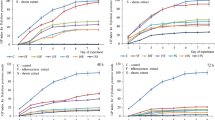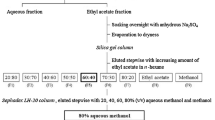Abstract
The allelopathic potential of the Tamarindus indica L. leaf was investigated through bioassay guided studies using several weed and edible crop species. Both radicle and hypocotyl growth of all the plant species tested was strongly inhibited by the tamarind leaf using a sandwich method. The growth of weed species was reduced more than that of edible crop species. Among the weed species, barnyard grass followed by white clover, and in the edible crop species, lettuce followed by radish ranked top in terms of growth inhibition. Different concentrations of tamarind leaf crude water-soluble extract exhibited a strong inhibition in all the plant species tested and, by contrast, the magnitude of inhibition in the weed species was higher than in edible crop species and ranged from 30–75%. The 10% concentration of the tamarind leaf crude water-soluble extract was most potent against growth of seedlings. The concentrations of the nutrient components were linearly correlated with an increase in the concentration of tamarind leaf crude water-soluble extract. No significant changes in either pH or EC were found in the variations of different concentrations of tamarind leaf crude water-soluble extracts. As compared to control, growth of both radicle and hypocotyl in weed (barnyard grass and white clover) and in edible crop (lettuce and radish) species were significantly reduced when blended tamarind leaves at different concentrations were incorporated into the growth medium. The inhibitory magnitude increased with an increase in the concentration of the tamarind leaf. In terms of growth inhibition, among these tested plants, weed species particularly barnyard grass were most sensitive to the allelochemicals exuded from blended tamarind leaves. When the blended tamarind leaves were removed from the growth medium, all the seedlings grew quickly and the percentage of recovery was between 76–97% of the corresponding controls. Reduction in the fresh and dry weight of these 4 plant species was observed under the experimental conditions, and ranged between 33–42% and 40–53% in the radicle and hypocotyl, respectively. The fresh and dry weight, and total chlorophyll content declined significantly in the incorporated tamarind leaf treatments. Compared to the control, the highest drop in the chlorophyll content of 60% in barnyard grass was observed with the 10% concentration of the leaf treatment. These results clearly indicate that the tamarind leaf contains one or more strong biologically active allelochemical(s) that function as true growth regulator(s) and is involved in plant growth regulation, particularly in weed species.
Similar content being viewed by others
References
Abreu J.C.D., Davide L.C., Davide A.C. and Souza I.F. 2001. Effects of aqueous extracts of Anadenanthera peregrina (L) Speg. on seed germination and seedling growth of lettuce (Lactuca sativa L). Allelopathy J. 8: 73–78.
Arnon R.D. 1949. Copper enzymes in isolated chloroplasts. Polyphenoloxidases in Beta vulgaris. Plant Physiol. 24: 1–15.
Bell D.T. and Koeppe D.E. 1972. Noncompetitive effects of giant foxtail on the growth of corn. Agron. J. 64: 321–325.
Drost D.C. and Doll J.D. 1980. The allelopathic effect of yellow nutsedge (Cyperus esculentus) on corn (Zea mays) and soybeans (Glycine max). Weed Sci. 28: 229–233.
El-Siddig K., Ebert G. and Ludders P. 2000. Emergence and early seedling growth of Tamarindus indica L. from geographically diverse populations in the Sudan. J. Applied Bot. 74: 17–20.
Fujii Y. and Ohmae Y. 2001. Allelopathy of the fallen tree leaves of the invaded and transported plants - Screening of allelopathic activity by sandwich and dishpack methods. J.Weed Sci. Tech. 46: 114–115.
Gressel J.B. and Holm L.G. 1964. Chemical inhibition of crop germination by weed seed and the nature of the innhibition by Abunlon theophrasii. Weed Res. 4: 44–53.
Lewis Y.S., Neelakantan S. and Bathia D.S. 1961. Organic acid metabolism in Tamarind leaves. Curr. Sci. 30: 381–382.
Matsumoto N., Gemma H., Nakatani K. and Fujii Y. 1999. Allelopathy of leaves from red pine tree and application for weed control in orchard garden. J. of Weed Sci. Tech. 44: 184–185.
Muller C.H. and Moral R.D. 1966. Soil toxicity induced by terpenes from Salvia leucophylla. Bull. Torrey Bot. Club. 93: 130–137.
Patnaik K.K. 1974. Seasonal pattern of tartaric acid metabolism underlying the phasic development in Tamarindus indica. Biol. Plant. 16: 1–6.
Pino J.A. 1998. Volatile constituents of tamarind (Tamarindus indica L.). Food and Feed Chem. 292: 85–87.
Qasem J.R. and Foy C.L. 2001. Chemical weed control and response to competition in majoram (Origanum syriacum). In the proceedings of the Southern Weed Science Society 54: 221.
Rice E.L. 1964. Inhibition of nitrogen-fixing and nitrifying bacteria by seed plants. I. Ecology. 45: 824–837.
Rice E.L. 1984. Allelopathy. 2nd edn. Academic Press, NY, USA.
Rice E.L. and Parenti R.L. 1967. Inhibition of nitrogen-fixing bacteria by seed plants. V. Inhibitors produced by Bromus japonicus Thumb. Southwest Natur. 12: 97–103.
Riffle M.S., Thilsted W.E., Murray D.S., Ahring R.M. and Waller G.R. 1988. Germinnation and seed production of unicorn-plant (Proboscidea louisianica). Weed Sci. 36: 787–791.
Riffle M.S., Waller G.R., Murray D.S. and Sgaramello R.P. 1990. Devil's-claw (Proboscidea louisianica), essential oil and its components: Potential allelochemical agents on cotton and wheat. J. Chem. Ecol. 16: 1927–1940.
Russo V.M., Webber C.L. and Myers D.L. 1997. Kenaf extract affects germination and post-germination development of weed, grass and vegetable seeds. Indus. Crop Produc. 6: 59–69.
Sahid I.B. and Sugau J.B. 1993. Allelopathic effect of lantana (Lantana camara) and siam weed (Chromolaena odorata) on selected crops. Weed Sci. 41: 303–308.
Sedgley M. and Gardner J.A. 1989. International survey of unexploited tropical and subtropical perennials. Acta Hort. 250: 1–2.
Shankarcharya N.B. 1998. Tamarind - chemistry, technology and uses - a critical appraisal. J. Food Sci. Technol. 35: 193–208.
Stachon W.J. and Zimdhal R.L. 1980. Allelopathic activity of Canada thistle (Cirsium arvense). Weed Sci. 28: 83–86.
Tinnian R.O. and Muller C.H. 1972. The allelopahtic influences of Avena fatuca: The allelopathic mechanism. Bull. Torrey Bot. Club. 99: 287–292.
Varshney J.G., Singh B.D. and Prakash O. 2001. Effect of aqueous extracts of winter weed species on nutsedge (Cyperus rotundus) germination and growth. Allelopathy J. 8: 85–88.
Whittaker R.H. 1971. The chemistry of communities. In: Biochemical Interactions Among Plants. Environmental Physiology US National Comm., IBP, Subcomm. Nat. Acad. Sci., Washington, DC, USA, pp. 10–18.
Wong K.C., Tan C.P., Chow C.H. and Chee S.G. 1998. Volatile constituents of the fruit of Tamarindus indica L. J. Essent. Oil Res. 10: 219–221.
Author information
Authors and Affiliations
Rights and permissions
About this article
Cite this article
Parvez, S.S., Parvez, M.M., Nishihara, E. et al. Tamarindus indica L. leaf is a source of allelopathic substance. Plant Growth Regulation 40, 107–115 (2003). https://doi.org/10.1023/A:1024237426416
Issue Date:
DOI: https://doi.org/10.1023/A:1024237426416




